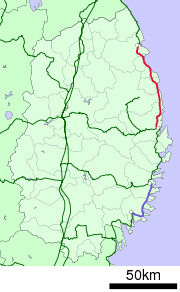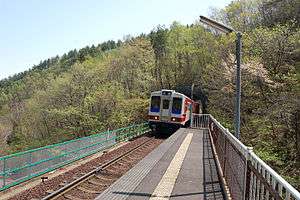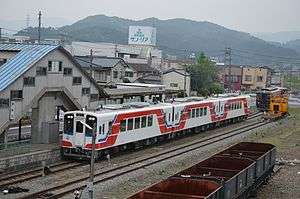Sanriku Railway

red:Kita-Riasu Line
blue:Minami-Riasu Line
The Sanriku Railway (三陸鉄道 Sanriku Tetsudō) is a railway company in Iwate Prefecture in northern Japan. The company and its lines are also known as Santetsu (三鉄). The company was founded in 1981, as the first "third sector" (half public, half private) railway line in the country, excluding special cases such as freight railways in seaports. Its lines are former Japanese National Railways (JNR) lines, that were going to be closed. Santetsu acquired these lines in 1984. The company also operates a travel agency and other businesses.
Lines
Kita-Rias Line
| Kita-Rias Line | |
|---|---|
 A train arriving at Shiraikaigan Station in May 2008 | |
| Overview | |
| Native name | 北リアス線 |
| Locale | Iwate Prefecture |
| Termini |
Miyako Kuji |
| Stations | 16 |
| Operation | |
| Owner | Sanriku Railway |
| Technical | |
| Line length | 71.0 km (44.1 mi) |
| Number of tracks | Single track |
| Track gauge | 1,067 mm (3 ft 6 in) |
| Electrification | none |
Station list
| Station | Japanese | Distance (km) |
Transfers | Location |
|---|---|---|---|---|
| Miyako | 宮古 | 0.0 | ■ Yamada Line | Miyako, Iwate |
| Yamaguchi Danchi | 山口団地 | 1.6 | ||
| Ichinowatari | 一の渡 | 6.2 | ||
| Sabane | 佐羽根 | 9.1 | ||
| Tarō | 田老 | 12.7 | ||
| Settai | 摂待 | 21.5 | ||
| Iwaizumi-Omoto | 岩泉小本 | 25.1 | Iwaizumi, Iwate | |
| Shimanokoshi | 島越 | 33.4 | Tanohata, Iwate | |
| Tanohata | 田野畑 | 35.6 | ||
| Fudai | 普代 | 44.9 | Fudai, Iwate | |
| Shiraikaigan | 白井海岸 | 48.3 | ||
| Horinai | 堀内 | 51.4 | ||
| Noda-Tamagawa | 野田玉川 | 55.9 | Noda, Iwate | |
| Tofugaura-Kaigan | 十府ヶ浦海岸 | 57.6 | ||
| Rikuchū-Noda | 陸中野田 | 59.9 | ||
| Rikuchū-Ube | 陸中宇部 | 63.3 | Kuji, Iwate | |
| Kuji | 久慈 | 71.0 | ■ Hachinohe Line |
History
The Japanese National Railways (JNR) opened the Miyako to Taro section in 1972 and the Kuji to Fudai section in 1975. It constructed the Taro to Fudai section, and transferred the entire line to Sanriku on the day it opened in 1984. The line features 42 tunnels, including the Masaki (6,532 m) and Omoto (5,174 m) tunnels, both opened in 1984.
Minami-Rias Line
| Minami-Rias Line | |
|---|---|
 A train arriving at Sakari Station in July 2014 | |
| Overview | |
| Native name | 南リアス線 |
| Locale | Iwate Prefecture |
| Termini |
Sakari Kamaishi |
| Stations | 10 |
| Operation | |
| Owner | Sanriku Railway |
| Technical | |
| Line length | 36.6 km (22.7 mi) |
| Number of tracks | Single track |
| Track gauge | 1,067 mm (3 ft 6 in) |
| Electrification | none |
Station list
| Station | Japanese | Distance (km) |
Transfers | Location |
|---|---|---|---|---|
| Sakari | 盛 | 0.0 | ■ Ōfunato Line | Ōfunato, Iwate |
| Rikuzen-Akasaki | 陸前赤崎 | 3.7 | ||
| Ryōri | 綾里 | 9.1 | ||
| Koishihama | 恋し浜 | 12.0 | ||
| Horei | 甫嶺 | 14.3 | ||
| Sanriku | 三陸 | 17.0 | ||
| Yoshihama | 吉浜 | 21.6 | ||
| Tōni | 唐丹 | 27.7 | ||
| Heita | 平田 | 33.1 | Kamaishi, Iwate | |
| Kamaishi | 釜石 | 36.6 |
History
JNR opened the Sakari to Ryori section in 1970, extending the line to Yoshihama in 1973. It constructed the section to Kamaishi and transferred the entire line to Sanriku on the day it opened in 1984. The line features 20 tunnels.
2011 earthquake and tsunami damage
Both lines were heavily damaged by the 2011 Tōhoku earthquake and tsunami.[1] The two lines suffered damage at 300 locations, including damage to station buildings and bridges. The tsunami washed away 5.8 km of railway tracks on the lines. Full restoration of service on the lines was completed in April 2014.[2]
Diesel railcars damaged by the earthquake and tsunami were replaced by three new diesel railcars funded by Kuwait. The new cars were introduced in January 2014.[3]
The two sections of the Sanriku Railway are separated by a destroyed segment of the Yamada Line. It is currently being rebuilt and is scheduled to reopen 22 March 2019.[4] Once rebuilt it will be transferred to Sanriku Railway, resulting in continuous service between Kuji and Ofunato.
See also
References
This article incorporates material from the corresponding article in the Japanese Wikipedia.
- ↑
- ↑ "Tsunami-hit Sanriku line fully operational". The Japan Times. 5 April 2014. Retrieved 16 June 2014.
- ↑ 三陸鉄道、新車両3両投入へ [Sanriku Railway to introduce 3 new cars]. Tetsudo.com (in Japanese). Japan: Asahi Interactive. 22 June 2012. Retrieved 22 June 2012.
- ↑ 三陸鉄道はいま、ひとつにつながるリアス線 (in Japanese). Retrieved 14 June 2018.
External links
| Wikimedia Commons has media related to Sanriku Railway. |
- Official website (in Japanese)